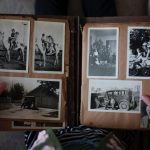Table of Contents
Origins of Quirkiness: Exploring Family Traits and Anecdotes
In the intricate tapestry of family history, there are threads woven with eccentricity that stand out like vibrant patches of color. These quirks and idiosyncrasies, passed down through generations, are like whispered secrets of our ancestors, offering a glimpse into the fascinating complexities of their lives. As we embark on this journey of unraveling the enigmatic origins of quirkiness within our lineage, we find that these peculiar traits are more than mere anecdotes—they’re the living legacy of our family’s uniqueness.
Eccentricity, often seen as the spice of life, is not confined to individual lifetimes but can manifest as a recurring theme across generations. Just as we inherit physical traits like eye color and height, the eccentricities of our forebears can also find their way into our DNA. The uncle with an uncanny ability to predict the weather, the grandmother who collected unusual trinkets from around the world, or the cousin with an affinity for speaking in rhymes—all these eccentricities are like hidden treasures, waiting to be unearthed as we delve into the annals of our family history.
One story that resonates down the corridors of time is that of Great-Aunt Matilda, whose penchant for befriending stray cats was not only endearing but also a testament to her kind heart. As the family lore goes, Matilda’s home resembled a feline sanctuary, with cats of all sizes and colors finding solace within her walls. This quirky trait of nurturing and caring for the abandoned echoes through the generations, as many family members today find themselves drawn to professions and hobbies centered around caregiving and advocacy.
But it’s not just the quirks themselves that make these stories fascinating; it’s the way they bridge the gap between eras. Take, for instance, the tale of Grandpa Edgar, known for his uncanny ability to fall asleep at the most unexpected times and places. This peculiar trait, seemingly inherited by a branch of the family tree, is not just a source of amusement—it’s a connection to a man who lived in a world vastly different from our own. As we chuckle about the time he dozed off during a lively wedding reception, we also remember the challenges he faced during the tumultuous times he lived through.
These anecdotes and tales of our origins of quirkiness set the tone for a journey of discovery, reminding us that our roots run deep and wide, reaching back to ancestors who dared to stand out, to be different. As we continue to explore the origins of quirkiness, we find ourselves embracing not just the oddities that make our family unique, but the shared humanity that binds us across time and generations. The legacy of eccentricity is a reminder that while times change, the essence of what makes us who we are remains a constant, transcending the boundaries of time and leaving an indelible mark on our family’s story.
The Enigmatic Storytellers: Eccentricities in Oral Histories
Every family possesses its own storytellers, those enigmatic figures who weave tales that bridge the gap between generations. Within their narratives, they unveil the mysteries and marvels of the past, sharing not only historical facts but also the quirks and eccentricities that make our lineage come alive. As we embark on a journey to uncover the role of these unique individuals in shaping the tapestry of our family narratives, we discover that it’s the infusion of eccentricities that adds the most vibrant hues to these oral histories.
Family legends are not just chronicles of events; they’re the enchanting stories that are passed down like precious heirlooms, infused with the essence of those who lived them. Enter the eccentric uncle who always had a knack for turning the mundane into the extraordinary. His mischievous wit and penchant for exaggeration gave birth to stories that grew more colorful with each retelling. That fishing trip that started with a minnow and ended with a legendary encounter with a sea monster—that was his masterpiece. Through his tales, our family bonds were strengthened, and our connection to the past was solidified.
These enigmatic storytellers don’t merely recount events; they shape the way we remember them. Aunt Lillian, with her ever-present twinkle in her eye, transformed even the most routine occurrences into captivating adventures. Her stories of local festivals became whimsical extravaganzas, complete with mystical creatures and fantastical quests. Her penchant for imaginative storytelling taught us to embrace imagination and to find magic in the everyday.
The role of these origins of quirkiness in our oral histories cannot be overstated. Their idiosyncrasies infuse narratives with authenticity and depth, painting a more holistic picture of our ancestors. That great-grandfather who had an insatiable curiosity for the stars, often disappearing into his makeshift observatory for nights on end, didn’t just study celestial bodies; he pursued his dreams with unwavering dedication. His story reminds us that the pursuit of passions is a timeless endeavor that knows no bounds.
In these oral histories, eccentricities don’t merely stand as quirks; they become symbols of resilience and individuality. The aunt who traveled the world collecting obscure artifacts left a legacy that reaches beyond her material possessions. She embodied the spirit of adventure and the courage to step beyond comfort zones—a lesson that reverberates through generations.
As we gather around family gatherings, or huddle together over virtual calls, the tales of these enigmatic storytellers are like windows into the past. Their unique perspectives enrich the narratives, offering insights into the lives of our ancestors that historical records might overlook. Through their words, we uncover not just facts, but the heartbeats of those who came before us. And in doing so, we honor the eccentricities that have shaped our family’s journey and celebrate the indelible mark they’ve left on the pages of our shared history.
Through the Lens of Time: Unconventional Lives in Historical Context
As we peer into the annals of history, we uncover a tapestry woven with threads of unconventional lives—individuals who defied societal norms and danced to the rhythm of their own eccentricities. These characters, seemingly out of step with their times, come alive as we explore the fascinating interplay between their quirks and the historical contexts in which they lived. From the outskirts of acceptability to the heart of innovation, their stories offer a window into how societal norms and cultural influences both shaped and were shaped by their behaviors.
Consider the case of the bohemian artist cousin who lived in the heart of a conservative Victorian era. While his contemporaries adhered to rigid codes of conduct, he reveled in creative chaos. His unconventional appearance and lifestyle choices—often adorned in colorful attire and speaking openly of abstract ideas—raised eyebrows, earning him a reputation as an eccentric. Yet, his artistic vision wasn’t just a personal indulgence; it challenged the artistic norms of the time and laid the foundation for the radical artistic movements that would emerge in the decades to come.
On the flip side, there’s the spinster aunt whose affinity for solitary botanical expeditions earned her the moniker of “the eccentric herbalist.” In a world where women were expected to marry and embrace domesticity, her unwavering commitment to her scientific pursuits was met with a mixture of admiration and bewilderment. Her determination to chart her own course in the face of societal pressures wasn’t just an act of rebellion—it was a testament to the resilience of women striving for intellectual independence.
Societal norms often shaped how eccentric behaviors were perceived. A distant relative who possessed an uncanny ability to communicate with animals found acceptance in rural communities where folklore and spirituality intertwined. In these locales, her connection with the natural world was celebrated, and her insights were sought after. However, had she resided in urban centers, her gift might have been met with skepticism or even ostracism, as modernization and rationality often clashed with the supernatural.
Another dimension of historical context lies in the convergence of societal attitudes and cultural influences. Take the great-grandfather who was known for hosting extravagant parties and espousing progressive political ideas. In certain cosmopolitan circles, his lavish soirées and bold political stance were seen as a mark of sophistication. However, in more conservative regions, his behaviors might have been seen as scandalous or even subversive. His eccentricities, though consistent, were received differently based on the prevailing cultural milieu.
The lives of these unconventional relatives remind us that history isn’t just a series of dates and events—it’s a tapestry woven from the interplay of individuals and their surroundings. Eccentricities weren’t just individual oddities; they were responses to the currents of their times, reflections of societal constraints and catalysts for change. Through their stories, we witness the complexity of human existence and the dynamic relationship between the individual and the society they inhabit. As we delve into their lives, we find ourselves not just uncovering family history, but gazing into the mirror of human experience itself.
Artifacts of Oddity: Uncovering Quirky Memorabilia and Keepsakes
Within the attics and drawers of family estates lie treasures that transcend the ordinary—a collection of artifacts that offer glimpses into the peculiar lives and passions of our ancestors. These seemingly eccentric memorabilia and keepsakes, far from being mere curiosities, hold the power to bridge the gap between generations and provide a unique window into the quirks, interests, and personalities that define our family heritage.
Consider the faded stack of letters exchanged between a great-uncle and a pen pal from a distant land. Through the ink-stained pages, we uncover a fascination with cryptic puzzles and riddles, revealing a quirky predilection for mental challenges. His epistolary exchanges offer more than just a peek into his wit; they speak of a time when connecting with like-minded individuals across oceans required patience and ingenuity, traits he undoubtedly possessed in abundance.
Or imagine stumbling upon a series of meticulously illustrated travel journals belonging to an adventurous aunt. Within their pages, intricately detailed sketches and vivid descriptions transport us to far-flung locales—a testament to her insatiable wanderlust. Her quirks are immortalized in the way she captured not just the iconic landmarks, but also the tiny, often overlooked details that spoke to her artist’s soul.
But it’s not always the conventional artifacts that hold the most fascination. Take, for instance, the family’s collection of mismatched teacups, an inheritance from a great-grandmother with an eccentric penchant for collecting the discarded. Each chipped saucer and delicately painted cup tells a story of thriftiness turned into artistry, revealing a woman who saw beauty where others might have seen only castoffs.
In the corners of an old workshop, you might discover a contraption assembled by a mechanically inclined grandfather—a contraption that never quite served its intended purpose. Its intricate design and curious mechanisms speak to his innovative spirit, his willingness to embrace experimentation even if it meant a few failures along the way. This artifact, while unconventional, encapsulates his determination to push boundaries and embrace the uncharted.
These quirky artifacts and keepsakes breathe life into our family history, revealing more than just the dates and names that form our genealogy. They provide the brushstrokes of personality, the strokes of passion, and the shades of eccentricity that color the lives of our ancestors. These tangible remnants of the past offer a sense of connection that transcends time, allowing us to empathize with their quirks and find common threads that link us across generations.
As we dust off these treasures and hold them in our hands, we’re not just handling objects; we’re holding a piece of our family’s collective soul. These artifacts are like keys that unlock the doors to understanding who we are, where we come from, and the myriad ways our ancestors’ quirks have shaped the contours of our own identities. Each peculiar piece is a testament to the rich tapestry of human experience, showcasing that even the odd and unconventional can be beautiful in its own intricate way.
Lessons from our Origins of Quirkiness: Embracing Individuality in Family Heritage
In the intricate mosaic of family history, there’s a profound beauty that emerges when we step back and truly embrace the diverse shades of individuality that color our ancestral tapestry. Our origins of quirkiness, those who danced to the beat of their own drums, beckon us to reflect on the powerful lessons they impart about celebrating diversity, inclusivity, and the liberating act of being authentically oneself.
Our lineage is far from a monochromatic canvas; it’s a vibrant symphony of personalities, passions, and perspectives. It’s the uncle who reveled in odd hobbies that made him stand out, the aunt who fearlessly pursued careers outside traditional boundaries, and the cousin who unapologetically adorned themselves in fashions that raised eyebrows. These unique individuals challenge us to shatter the molds of conformity and find the courage to express our true selves, just as they did.
When we celebrate our quirky ancestors, we not only honor their memory but also embrace a vital message of inclusivity. Their presence in our family history teaches us that diversity isn’t merely a buzzword; it’s the heartbeat of our shared narrative. Through their stories, we learn that inclusivity extends beyond the confines of race, religion, or societal norms—it encompasses the multiplicity of personalities that make us human. Our ancestors show us that the richness of our family heritage is found in the kaleidoscope of oddities, and it’s a legacy worth cherishing.
But embracing individuality isn’t merely a token gesture; it’s a transformative journey that enriches our understanding of who we are. The great-aunt who defied conventions to pursue her passion for science becomes a beacon of inspiration for generations who follow. Her story is a testament to the power of pursuing what lights the soul on fire, even when societal pressures try to extinguish the flame. By absorbing these lessons, we learn that understanding our roots isn’t about conforming to a pre-set mold; it’s about embracing our individual essence and allowing it to flourish.
Our origins of quirkiness also teach us the freedom of authenticity. In a world often obsessed with fitting in, their legacy reminds us that true happiness comes from embracing our quirks, passions, and peculiarities. As we uncover their stories, we find permission to be unapologetically ourselves. Their tales invite us to paint our own strokes on the canvas of our family history, adding to the kaleidoscope of uniqueness that stretches across generations.
In the grand narrative of family, the celebration of diversity and the embrace of individuality are not just lofty ideals; they’re the cornerstones upon which our identity is built. As we learn from our origins of quirkiness, we discover that it’s the outliers, the misfits, and the rebels who often leave the most indelible marks. By weaving their stories into our family tapestry, we honor their legacy and amplify their message—the message of embracing who we are, cherishing who they were, and shaping a future that resonates with the joyous celebration of being authentically, wonderfully, and beautifully ourselves.
Image Source:
- Photo by Llyfrgell Genedlaethol Cymru / The National Library of Wales: instant images





